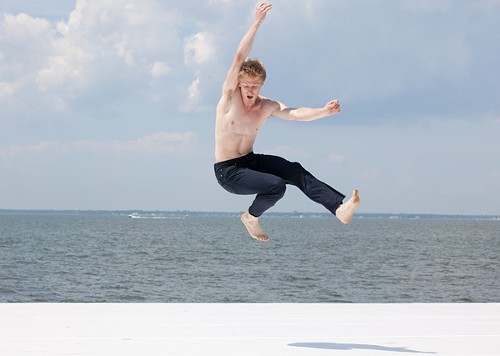
Brian Brooks Moving Company
July 16-18
American Dance Festival
Reynolds Industries Theater
Brian Brooks makes a big production out of very little material. He choreographs all of the dances, which initially give the impression of being big and glitzy, for the aptly named Brian Brooks Moving Company. And he does it with a limited vocabulary that depends on virtuosic physical expression for what interest it arouses.
The dancers are supremely fit body-machines, capable of many rapid repetitions without pause. The body and certain aspects of its capabilities (such as, how close can one get to perpetual motion?) seem to be the main area of exploration for Brooks. And aggression. There’s a lot of aggression, playful and not, in the dances in the BBMC program in Reynolds Theater at the American Dance Festival this year.
Big City (2012) opens the program. Seven dancers amid a forest of hanging, articulated shiny metal tubes, perform to a relentless score by Jonathan Pratt. Like rats in a crowded cage, or workers in Manhattan, all seven struggle ceaselessly for dominance, success and survival among the glittering canyons of the sharp-edged city. They do the same things again and again and again, and since those things are not all that interesting, and since the pace changes only to become a little more frenetic, I became very tired of it well before the curtain lowered on the last man moving.
One section stands out, however. Brooks writhes and rolls among the shiny rods, never touching a one, his hands and feet making stepping stones along the path he creates for the diminutive Jo-anne Lee, who treads them, balancing with outspread arms as he turns beneath her.
In the solo I’m Going to Explode (2007), Brooks shows off his muscular skills as a suited white-collar worker having a minor freak-out before putting his jacket back on and trudging back to his job. It’s clever but shallow. Again, the idea runs out before the dance stops.
Descent (2011) includes more memorable images—as opposed to forgettable blurs of repetitive motion—than any of the other pieces included here. The power of these images was greatly enhanced by the striped lighting designed by Philip Treviño, but there’s nothing in the way of dramatic build. A scene in which dancers cross the dim stage while fanning lengths of colored gossamer cloth aloft into the light seduces the eye; the smoke-like curls of cloth recall the stage smoke puffing into the first scene, in which a walking dancer carries on another angled stiff across his shoulders. As the pair moves slowly through the striped light, they are joined by two more pairs, drifting. Other than that instance, it was not clear how the scenes related to each other.
I had been looking forward to Motor (2010), which received several positive reviews after its performance at the Joyce Theater in New York last year. The set looked fantastic in photos—all reviewers commented on it—and the subject seemed ideal for BBMC. However, in this program, only an excerpt is performed, and there is no set. Brooks and David Scarantino dance a duet. Their hopping abilities are extraordinary. They move around the stage in unison, on one leg each, and the leg-changes are so cleverly managed that one hardly sees them. It’s quite a feat—dancesport—and perhaps it makes sense within the context of the full dance. As it was, it seemed like Mark Dendy or Larry Keigwin Lite. Very Lite. Definitely less filling.
This is the third time I seen Brian Brooks Moving Company perform, and the third time I’ve seen the same tropes and movement sequences repeated throughout the evening, to much the same surface effect. Brooks and company do what they do very well, but what they touch no deep chord of emotion, nor light up the synapses with syncretic understanding. And the work is not entertaining enough to keep this viewer happy in the shallows of movement for movement’s sake.


